Managing and Leading: Line Managers and Leaders' Roles in Business
VerifiedAdded on 2021/02/19
|13
|4257
|19
Report
AI Summary
This report delves into the essential roles of line managers and leaders within an organisation, emphasizing their impact on employee motivation and engagement for organisational renewal. The introduction underscores the significance of employee motivation and engagement for achieving business goals and fostering a positive work environment. The main body identifies and evaluates the relationship between line managers and leaders, highlighting their responsibilities in resource allocation, decision-making, and communication. The report further examines how line managers and leaders can motivate and engage employees during organisational renewal by improving communication, providing continuous feedback, creating a positive environment, and clarifying goals and responsibilities. It also explores various models of motivation and engagement, offering practical strategies for enhancing employee performance and achieving organisational objectives. The conclusion summarises the importance of effective leadership and management in driving organisational success.
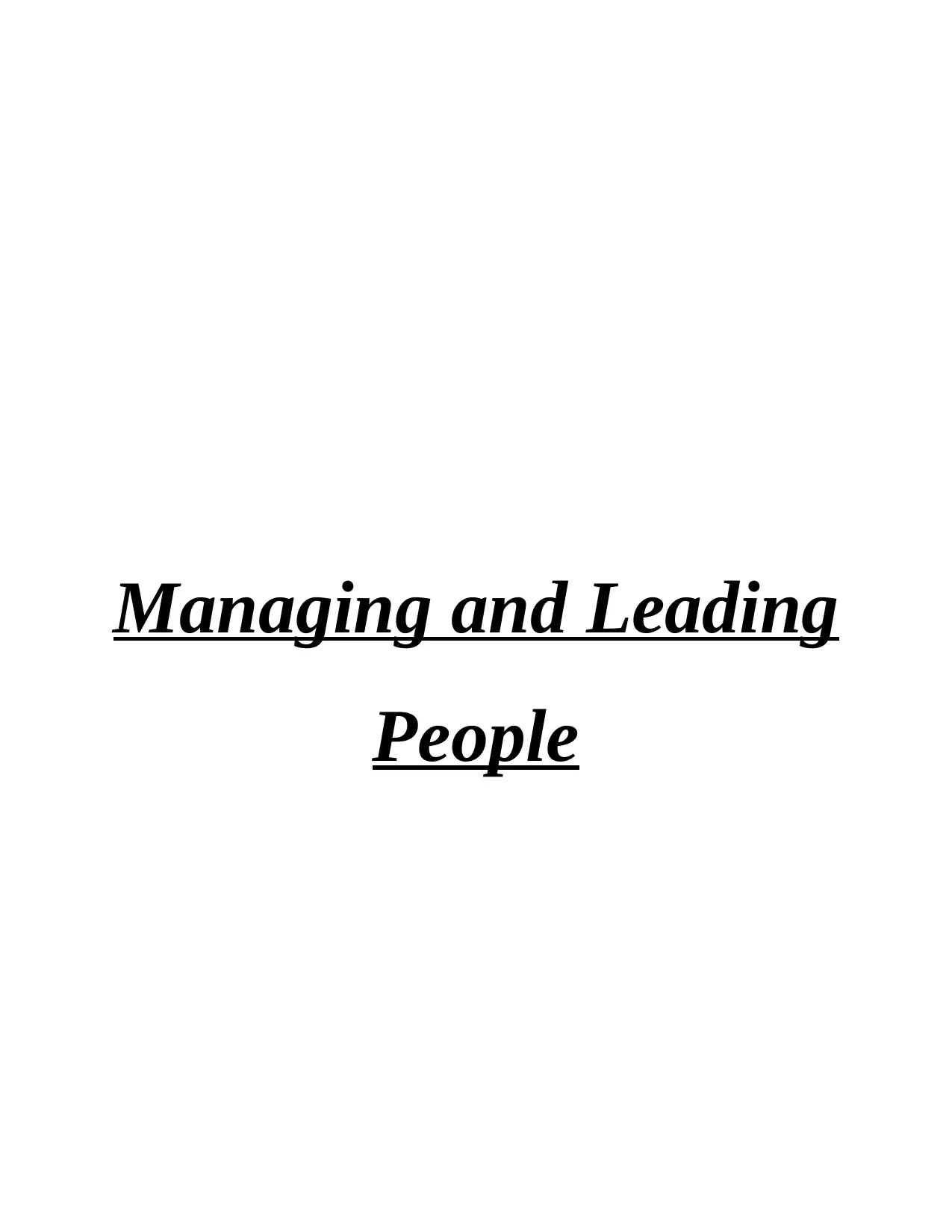
Managing and Leading
People
People
Paraphrase This Document
Need a fresh take? Get an instant paraphrase of this document with our AI Paraphraser
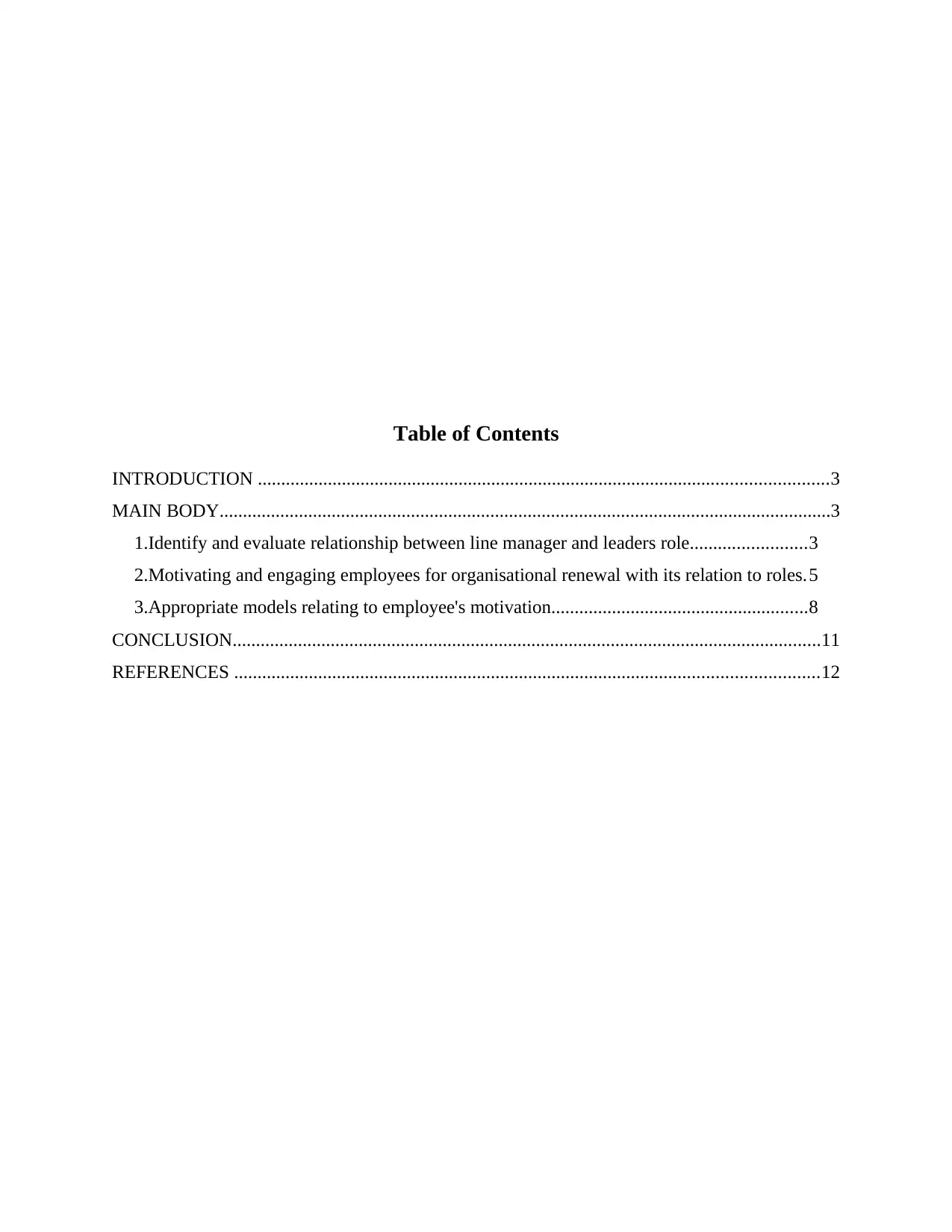
Table of Contents
INTRODUCTION ..........................................................................................................................3
MAIN BODY...................................................................................................................................3
1.Identify and evaluate relationship between line manager and leaders role.........................3
2.Motivating and engaging employees for organisational renewal with its relation to roles.5
3.Appropriate models relating to employee's motivation.......................................................8
CONCLUSION..............................................................................................................................11
REFERENCES .............................................................................................................................12
INTRODUCTION ..........................................................................................................................3
MAIN BODY...................................................................................................................................3
1.Identify and evaluate relationship between line manager and leaders role.........................3
2.Motivating and engaging employees for organisational renewal with its relation to roles.5
3.Appropriate models relating to employee's motivation.......................................................8
CONCLUSION..............................................................................................................................11
REFERENCES .............................................................................................................................12
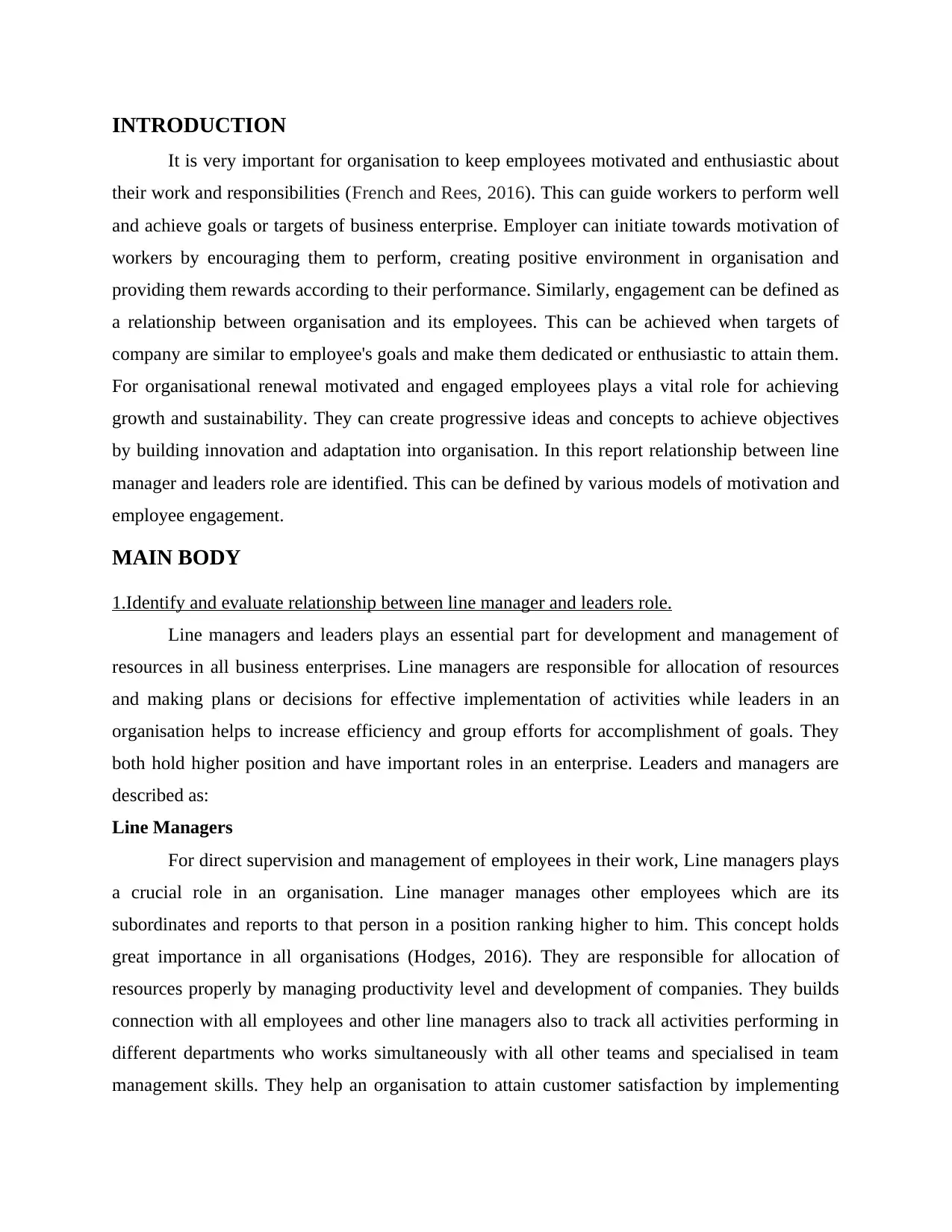
INTRODUCTION
It is very important for organisation to keep employees motivated and enthusiastic about
their work and responsibilities (French and Rees, 2016). This can guide workers to perform well
and achieve goals or targets of business enterprise. Employer can initiate towards motivation of
workers by encouraging them to perform, creating positive environment in organisation and
providing them rewards according to their performance. Similarly, engagement can be defined as
a relationship between organisation and its employees. This can be achieved when targets of
company are similar to employee's goals and make them dedicated or enthusiastic to attain them.
For organisational renewal motivated and engaged employees plays a vital role for achieving
growth and sustainability. They can create progressive ideas and concepts to achieve objectives
by building innovation and adaptation into organisation. In this report relationship between line
manager and leaders role are identified. This can be defined by various models of motivation and
employee engagement.
MAIN BODY
1.Identify and evaluate relationship between line manager and leaders role.
Line managers and leaders plays an essential part for development and management of
resources in all business enterprises. Line managers are responsible for allocation of resources
and making plans or decisions for effective implementation of activities while leaders in an
organisation helps to increase efficiency and group efforts for accomplishment of goals. They
both hold higher position and have important roles in an enterprise. Leaders and managers are
described as:
Line Managers
For direct supervision and management of employees in their work, Line managers plays
a crucial role in an organisation. Line manager manages other employees which are its
subordinates and reports to that person in a position ranking higher to him. This concept holds
great importance in all organisations (Hodges, 2016). They are responsible for allocation of
resources properly by managing productivity level and development of companies. They builds
connection with all employees and other line managers also to track all activities performing in
different departments who works simultaneously with all other teams and specialised in team
management skills. They help an organisation to attain customer satisfaction by implementing
It is very important for organisation to keep employees motivated and enthusiastic about
their work and responsibilities (French and Rees, 2016). This can guide workers to perform well
and achieve goals or targets of business enterprise. Employer can initiate towards motivation of
workers by encouraging them to perform, creating positive environment in organisation and
providing them rewards according to their performance. Similarly, engagement can be defined as
a relationship between organisation and its employees. This can be achieved when targets of
company are similar to employee's goals and make them dedicated or enthusiastic to attain them.
For organisational renewal motivated and engaged employees plays a vital role for achieving
growth and sustainability. They can create progressive ideas and concepts to achieve objectives
by building innovation and adaptation into organisation. In this report relationship between line
manager and leaders role are identified. This can be defined by various models of motivation and
employee engagement.
MAIN BODY
1.Identify and evaluate relationship between line manager and leaders role.
Line managers and leaders plays an essential part for development and management of
resources in all business enterprises. Line managers are responsible for allocation of resources
and making plans or decisions for effective implementation of activities while leaders in an
organisation helps to increase efficiency and group efforts for accomplishment of goals. They
both hold higher position and have important roles in an enterprise. Leaders and managers are
described as:
Line Managers
For direct supervision and management of employees in their work, Line managers plays
a crucial role in an organisation. Line manager manages other employees which are its
subordinates and reports to that person in a position ranking higher to him. This concept holds
great importance in all organisations (Hodges, 2016). They are responsible for allocation of
resources properly by managing productivity level and development of companies. They builds
connection with all employees and other line managers also to track all activities performing in
different departments who works simultaneously with all other teams and specialised in team
management skills. They help an organisation to attain customer satisfaction by implementing
⊘ This is a preview!⊘
Do you want full access?
Subscribe today to unlock all pages.

Trusted by 1+ million students worldwide
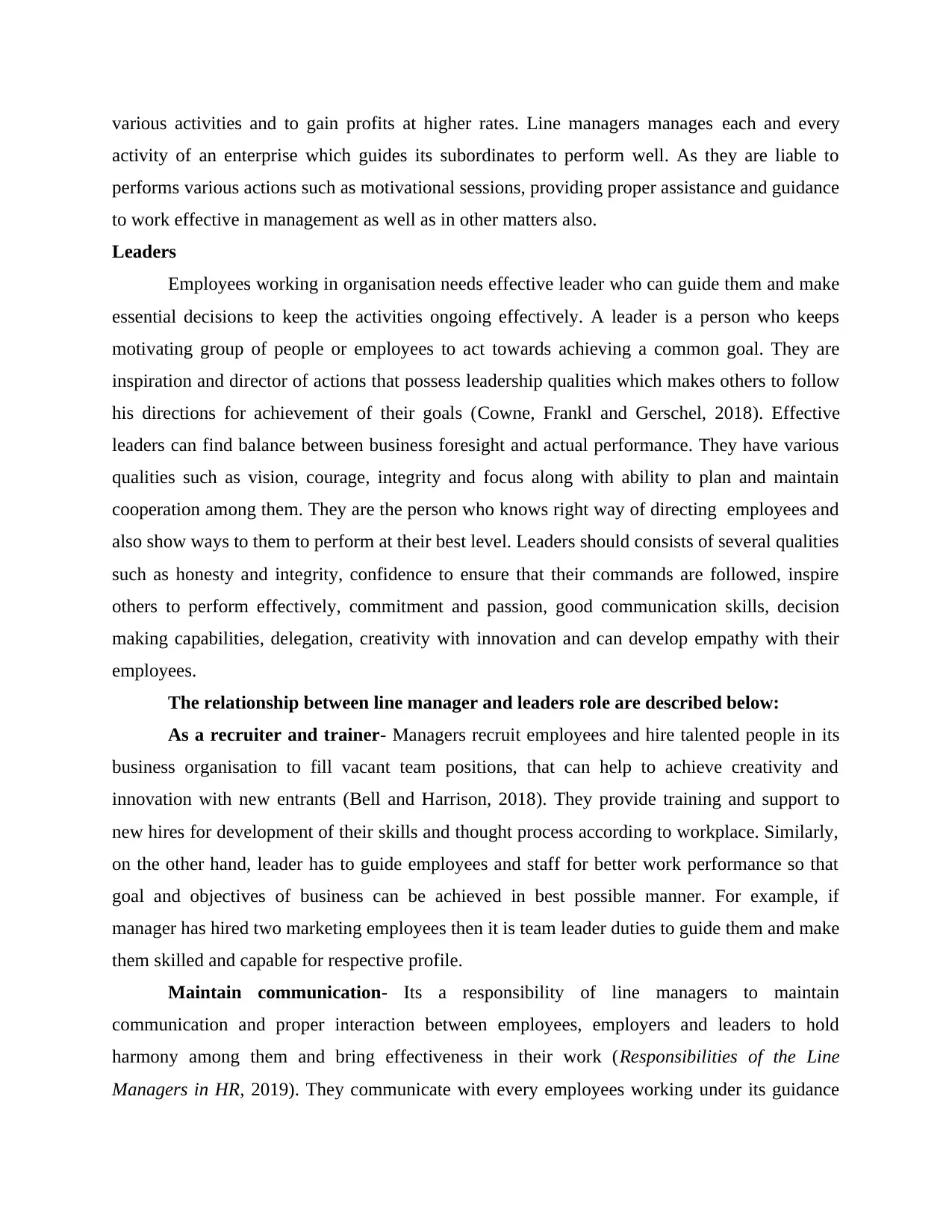
various activities and to gain profits at higher rates. Line managers manages each and every
activity of an enterprise which guides its subordinates to perform well. As they are liable to
performs various actions such as motivational sessions, providing proper assistance and guidance
to work effective in management as well as in other matters also.
Leaders
Employees working in organisation needs effective leader who can guide them and make
essential decisions to keep the activities ongoing effectively. A leader is a person who keeps
motivating group of people or employees to act towards achieving a common goal. They are
inspiration and director of actions that possess leadership qualities which makes others to follow
his directions for achievement of their goals (Cowne, Frankl and Gerschel, 2018). Effective
leaders can find balance between business foresight and actual performance. They have various
qualities such as vision, courage, integrity and focus along with ability to plan and maintain
cooperation among them. They are the person who knows right way of directing employees and
also show ways to them to perform at their best level. Leaders should consists of several qualities
such as honesty and integrity, confidence to ensure that their commands are followed, inspire
others to perform effectively, commitment and passion, good communication skills, decision
making capabilities, delegation, creativity with innovation and can develop empathy with their
employees.
The relationship between line manager and leaders role are described below:
As a recruiter and trainer- Managers recruit employees and hire talented people in its
business organisation to fill vacant team positions, that can help to achieve creativity and
innovation with new entrants (Bell and Harrison, 2018). They provide training and support to
new hires for development of their skills and thought process according to workplace. Similarly,
on the other hand, leader has to guide employees and staff for better work performance so that
goal and objectives of business can be achieved in best possible manner. For example, if
manager has hired two marketing employees then it is team leader duties to guide them and make
them skilled and capable for respective profile.
Maintain communication- Its a responsibility of line managers to maintain
communication and proper interaction between employees, employers and leaders to hold
harmony among them and bring effectiveness in their work (Responsibilities of the Line
Managers in HR, 2019). They communicate with every employees working under its guidance
activity of an enterprise which guides its subordinates to perform well. As they are liable to
performs various actions such as motivational sessions, providing proper assistance and guidance
to work effective in management as well as in other matters also.
Leaders
Employees working in organisation needs effective leader who can guide them and make
essential decisions to keep the activities ongoing effectively. A leader is a person who keeps
motivating group of people or employees to act towards achieving a common goal. They are
inspiration and director of actions that possess leadership qualities which makes others to follow
his directions for achievement of their goals (Cowne, Frankl and Gerschel, 2018). Effective
leaders can find balance between business foresight and actual performance. They have various
qualities such as vision, courage, integrity and focus along with ability to plan and maintain
cooperation among them. They are the person who knows right way of directing employees and
also show ways to them to perform at their best level. Leaders should consists of several qualities
such as honesty and integrity, confidence to ensure that their commands are followed, inspire
others to perform effectively, commitment and passion, good communication skills, decision
making capabilities, delegation, creativity with innovation and can develop empathy with their
employees.
The relationship between line manager and leaders role are described below:
As a recruiter and trainer- Managers recruit employees and hire talented people in its
business organisation to fill vacant team positions, that can help to achieve creativity and
innovation with new entrants (Bell and Harrison, 2018). They provide training and support to
new hires for development of their skills and thought process according to workplace. Similarly,
on the other hand, leader has to guide employees and staff for better work performance so that
goal and objectives of business can be achieved in best possible manner. For example, if
manager has hired two marketing employees then it is team leader duties to guide them and make
them skilled and capable for respective profile.
Maintain communication- Its a responsibility of line managers to maintain
communication and proper interaction between employees, employers and leaders to hold
harmony among them and bring effectiveness in their work (Responsibilities of the Line
Managers in HR, 2019). They communicate with every employees working under its guidance
Paraphrase This Document
Need a fresh take? Get an instant paraphrase of this document with our AI Paraphraser
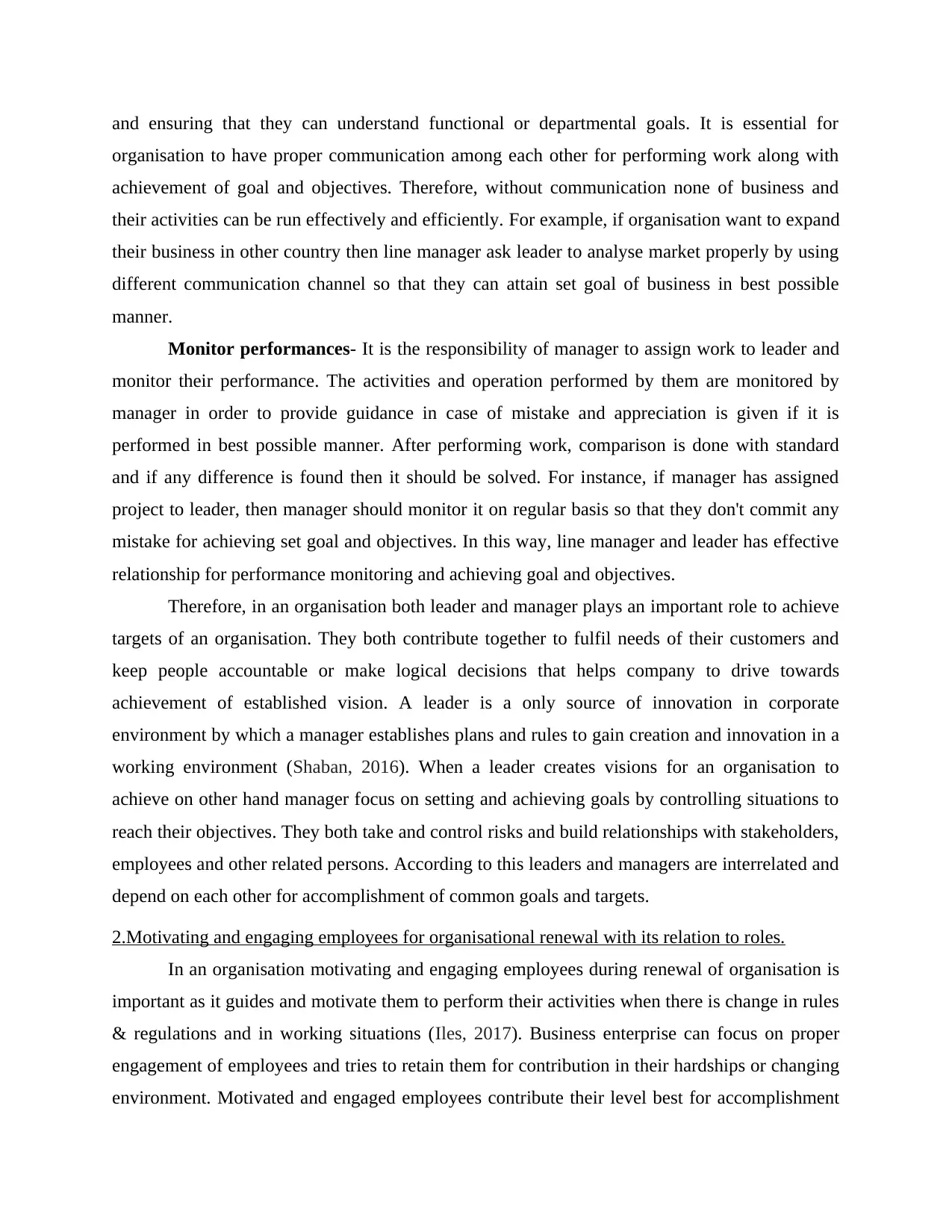
and ensuring that they can understand functional or departmental goals. It is essential for
organisation to have proper communication among each other for performing work along with
achievement of goal and objectives. Therefore, without communication none of business and
their activities can be run effectively and efficiently. For example, if organisation want to expand
their business in other country then line manager ask leader to analyse market properly by using
different communication channel so that they can attain set goal of business in best possible
manner.
Monitor performances- It is the responsibility of manager to assign work to leader and
monitor their performance. The activities and operation performed by them are monitored by
manager in order to provide guidance in case of mistake and appreciation is given if it is
performed in best possible manner. After performing work, comparison is done with standard
and if any difference is found then it should be solved. For instance, if manager has assigned
project to leader, then manager should monitor it on regular basis so that they don't commit any
mistake for achieving set goal and objectives. In this way, line manager and leader has effective
relationship for performance monitoring and achieving goal and objectives.
Therefore, in an organisation both leader and manager plays an important role to achieve
targets of an organisation. They both contribute together to fulfil needs of their customers and
keep people accountable or make logical decisions that helps company to drive towards
achievement of established vision. A leader is a only source of innovation in corporate
environment by which a manager establishes plans and rules to gain creation and innovation in a
working environment (Shaban, 2016). When a leader creates visions for an organisation to
achieve on other hand manager focus on setting and achieving goals by controlling situations to
reach their objectives. They both take and control risks and build relationships with stakeholders,
employees and other related persons. According to this leaders and managers are interrelated and
depend on each other for accomplishment of common goals and targets.
2.Motivating and engaging employees for organisational renewal with its relation to roles.
In an organisation motivating and engaging employees during renewal of organisation is
important as it guides and motivate them to perform their activities when there is change in rules
& regulations and in working situations (Iles, 2017). Business enterprise can focus on proper
engagement of employees and tries to retain them for contribution in their hardships or changing
environment. Motivated and engaged employees contribute their level best for accomplishment
organisation to have proper communication among each other for performing work along with
achievement of goal and objectives. Therefore, without communication none of business and
their activities can be run effectively and efficiently. For example, if organisation want to expand
their business in other country then line manager ask leader to analyse market properly by using
different communication channel so that they can attain set goal of business in best possible
manner.
Monitor performances- It is the responsibility of manager to assign work to leader and
monitor their performance. The activities and operation performed by them are monitored by
manager in order to provide guidance in case of mistake and appreciation is given if it is
performed in best possible manner. After performing work, comparison is done with standard
and if any difference is found then it should be solved. For instance, if manager has assigned
project to leader, then manager should monitor it on regular basis so that they don't commit any
mistake for achieving set goal and objectives. In this way, line manager and leader has effective
relationship for performance monitoring and achieving goal and objectives.
Therefore, in an organisation both leader and manager plays an important role to achieve
targets of an organisation. They both contribute together to fulfil needs of their customers and
keep people accountable or make logical decisions that helps company to drive towards
achievement of established vision. A leader is a only source of innovation in corporate
environment by which a manager establishes plans and rules to gain creation and innovation in a
working environment (Shaban, 2016). When a leader creates visions for an organisation to
achieve on other hand manager focus on setting and achieving goals by controlling situations to
reach their objectives. They both take and control risks and build relationships with stakeholders,
employees and other related persons. According to this leaders and managers are interrelated and
depend on each other for accomplishment of common goals and targets.
2.Motivating and engaging employees for organisational renewal with its relation to roles.
In an organisation motivating and engaging employees during renewal of organisation is
important as it guides and motivate them to perform their activities when there is change in rules
& regulations and in working situations (Iles, 2017). Business enterprise can focus on proper
engagement of employees and tries to retain them for contribution in their hardships or changing
environment. Motivated and engaged employees contribute their level best for accomplishment
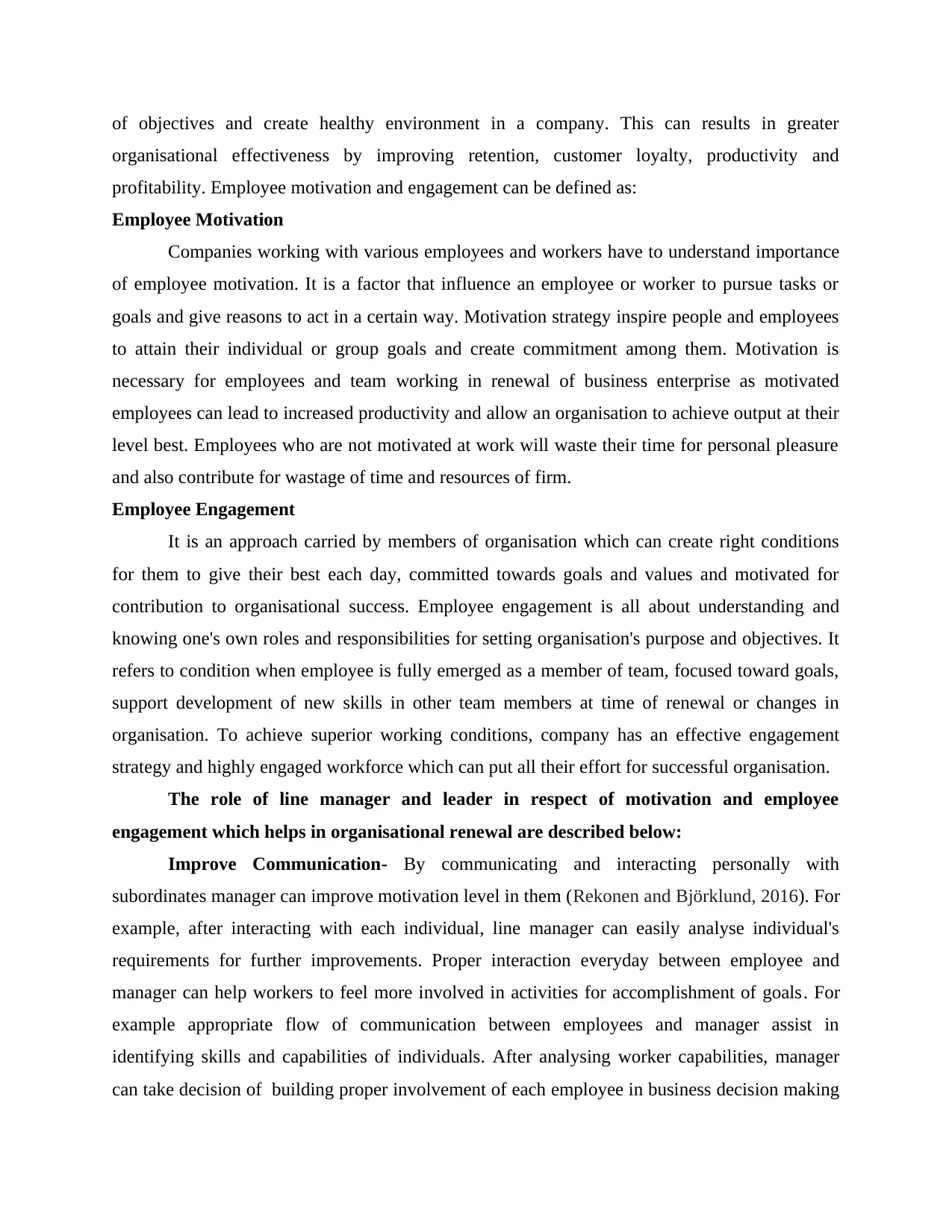
of objectives and create healthy environment in a company. This can results in greater
organisational effectiveness by improving retention, customer loyalty, productivity and
profitability. Employee motivation and engagement can be defined as:
Employee Motivation
Companies working with various employees and workers have to understand importance
of employee motivation. It is a factor that influence an employee or worker to pursue tasks or
goals and give reasons to act in a certain way. Motivation strategy inspire people and employees
to attain their individual or group goals and create commitment among them. Motivation is
necessary for employees and team working in renewal of business enterprise as motivated
employees can lead to increased productivity and allow an organisation to achieve output at their
level best. Employees who are not motivated at work will waste their time for personal pleasure
and also contribute for wastage of time and resources of firm.
Employee Engagement
It is an approach carried by members of organisation which can create right conditions
for them to give their best each day, committed towards goals and values and motivated for
contribution to organisational success. Employee engagement is all about understanding and
knowing one's own roles and responsibilities for setting organisation's purpose and objectives. It
refers to condition when employee is fully emerged as a member of team, focused toward goals,
support development of new skills in other team members at time of renewal or changes in
organisation. To achieve superior working conditions, company has an effective engagement
strategy and highly engaged workforce which can put all their effort for successful organisation.
The role of line manager and leader in respect of motivation and employee
engagement which helps in organisational renewal are described below:
Improve Communication- By communicating and interacting personally with
subordinates manager can improve motivation level in them (Rekonen and Björklund, 2016). For
example, after interacting with each individual, line manager can easily analyse individual's
requirements for further improvements. Proper interaction everyday between employee and
manager can help workers to feel more involved in activities for accomplishment of goals. For
example appropriate flow of communication between employees and manager assist in
identifying skills and capabilities of individuals. After analysing worker capabilities, manager
can take decision of building proper involvement of each employee in business decision making
organisational effectiveness by improving retention, customer loyalty, productivity and
profitability. Employee motivation and engagement can be defined as:
Employee Motivation
Companies working with various employees and workers have to understand importance
of employee motivation. It is a factor that influence an employee or worker to pursue tasks or
goals and give reasons to act in a certain way. Motivation strategy inspire people and employees
to attain their individual or group goals and create commitment among them. Motivation is
necessary for employees and team working in renewal of business enterprise as motivated
employees can lead to increased productivity and allow an organisation to achieve output at their
level best. Employees who are not motivated at work will waste their time for personal pleasure
and also contribute for wastage of time and resources of firm.
Employee Engagement
It is an approach carried by members of organisation which can create right conditions
for them to give their best each day, committed towards goals and values and motivated for
contribution to organisational success. Employee engagement is all about understanding and
knowing one's own roles and responsibilities for setting organisation's purpose and objectives. It
refers to condition when employee is fully emerged as a member of team, focused toward goals,
support development of new skills in other team members at time of renewal or changes in
organisation. To achieve superior working conditions, company has an effective engagement
strategy and highly engaged workforce which can put all their effort for successful organisation.
The role of line manager and leader in respect of motivation and employee
engagement which helps in organisational renewal are described below:
Improve Communication- By communicating and interacting personally with
subordinates manager can improve motivation level in them (Rekonen and Björklund, 2016). For
example, after interacting with each individual, line manager can easily analyse individual's
requirements for further improvements. Proper interaction everyday between employee and
manager can help workers to feel more involved in activities for accomplishment of goals. For
example appropriate flow of communication between employees and manager assist in
identifying skills and capabilities of individuals. After analysing worker capabilities, manager
can take decision of building proper involvement of each employee in business decision making
⊘ This is a preview!⊘
Do you want full access?
Subscribe today to unlock all pages.

Trusted by 1+ million students worldwide
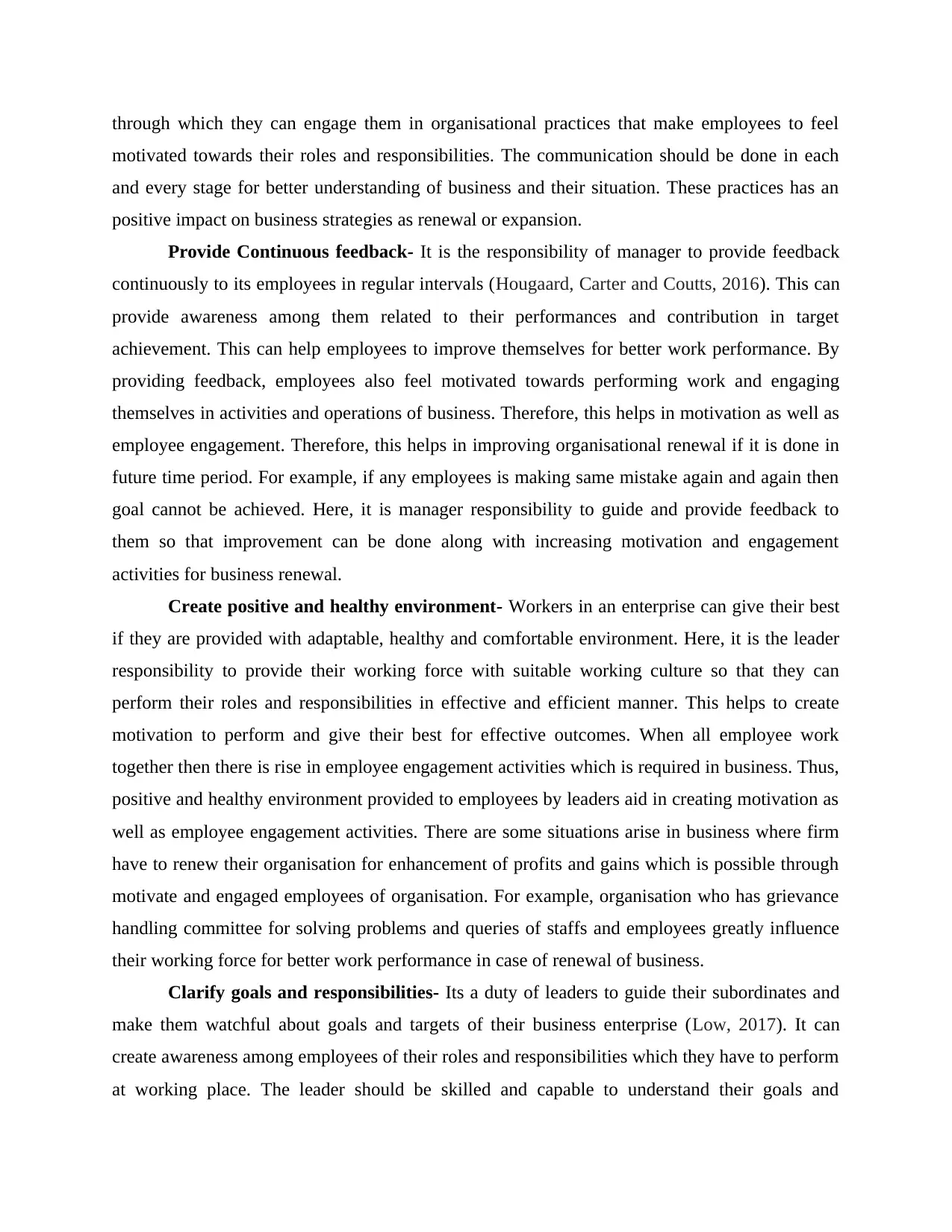
through which they can engage them in organisational practices that make employees to feel
motivated towards their roles and responsibilities. The communication should be done in each
and every stage for better understanding of business and their situation. These practices has an
positive impact on business strategies as renewal or expansion.
Provide Continuous feedback- It is the responsibility of manager to provide feedback
continuously to its employees in regular intervals (Hougaard, Carter and Coutts, 2016). This can
provide awareness among them related to their performances and contribution in target
achievement. This can help employees to improve themselves for better work performance. By
providing feedback, employees also feel motivated towards performing work and engaging
themselves in activities and operations of business. Therefore, this helps in motivation as well as
employee engagement. Therefore, this helps in improving organisational renewal if it is done in
future time period. For example, if any employees is making same mistake again and again then
goal cannot be achieved. Here, it is manager responsibility to guide and provide feedback to
them so that improvement can be done along with increasing motivation and engagement
activities for business renewal.
Create positive and healthy environment- Workers in an enterprise can give their best
if they are provided with adaptable, healthy and comfortable environment. Here, it is the leader
responsibility to provide their working force with suitable working culture so that they can
perform their roles and responsibilities in effective and efficient manner. This helps to create
motivation to perform and give their best for effective outcomes. When all employee work
together then there is rise in employee engagement activities which is required in business. Thus,
positive and healthy environment provided to employees by leaders aid in creating motivation as
well as employee engagement activities. There are some situations arise in business where firm
have to renew their organisation for enhancement of profits and gains which is possible through
motivate and engaged employees of organisation. For example, organisation who has grievance
handling committee for solving problems and queries of staffs and employees greatly influence
their working force for better work performance in case of renewal of business.
Clarify goals and responsibilities- Its a duty of leaders to guide their subordinates and
make them watchful about goals and targets of their business enterprise (Low, 2017). It can
create awareness among employees of their roles and responsibilities which they have to perform
at working place. The leader should be skilled and capable to understand their goals and
motivated towards their roles and responsibilities. The communication should be done in each
and every stage for better understanding of business and their situation. These practices has an
positive impact on business strategies as renewal or expansion.
Provide Continuous feedback- It is the responsibility of manager to provide feedback
continuously to its employees in regular intervals (Hougaard, Carter and Coutts, 2016). This can
provide awareness among them related to their performances and contribution in target
achievement. This can help employees to improve themselves for better work performance. By
providing feedback, employees also feel motivated towards performing work and engaging
themselves in activities and operations of business. Therefore, this helps in motivation as well as
employee engagement. Therefore, this helps in improving organisational renewal if it is done in
future time period. For example, if any employees is making same mistake again and again then
goal cannot be achieved. Here, it is manager responsibility to guide and provide feedback to
them so that improvement can be done along with increasing motivation and engagement
activities for business renewal.
Create positive and healthy environment- Workers in an enterprise can give their best
if they are provided with adaptable, healthy and comfortable environment. Here, it is the leader
responsibility to provide their working force with suitable working culture so that they can
perform their roles and responsibilities in effective and efficient manner. This helps to create
motivation to perform and give their best for effective outcomes. When all employee work
together then there is rise in employee engagement activities which is required in business. Thus,
positive and healthy environment provided to employees by leaders aid in creating motivation as
well as employee engagement activities. There are some situations arise in business where firm
have to renew their organisation for enhancement of profits and gains which is possible through
motivate and engaged employees of organisation. For example, organisation who has grievance
handling committee for solving problems and queries of staffs and employees greatly influence
their working force for better work performance in case of renewal of business.
Clarify goals and responsibilities- Its a duty of leaders to guide their subordinates and
make them watchful about goals and targets of their business enterprise (Low, 2017). It can
create awareness among employees of their roles and responsibilities which they have to perform
at working place. The leader should be skilled and capable to understand their goals and
Paraphrase This Document
Need a fresh take? Get an instant paraphrase of this document with our AI Paraphraser
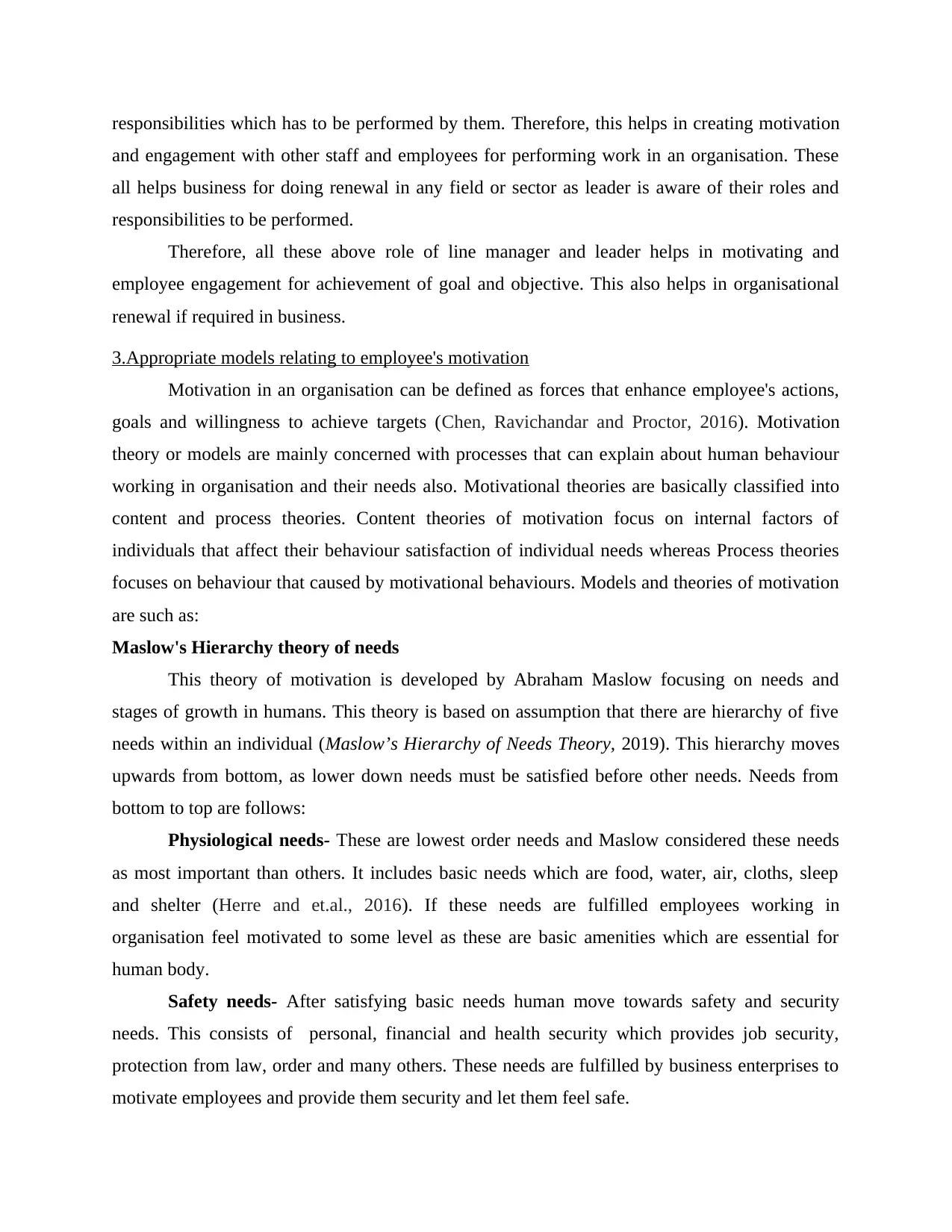
responsibilities which has to be performed by them. Therefore, this helps in creating motivation
and engagement with other staff and employees for performing work in an organisation. These
all helps business for doing renewal in any field or sector as leader is aware of their roles and
responsibilities to be performed.
Therefore, all these above role of line manager and leader helps in motivating and
employee engagement for achievement of goal and objective. This also helps in organisational
renewal if required in business.
3.Appropriate models relating to employee's motivation
Motivation in an organisation can be defined as forces that enhance employee's actions,
goals and willingness to achieve targets (Chen, Ravichandar and Proctor, 2016). Motivation
theory or models are mainly concerned with processes that can explain about human behaviour
working in organisation and their needs also. Motivational theories are basically classified into
content and process theories. Content theories of motivation focus on internal factors of
individuals that affect their behaviour satisfaction of individual needs whereas Process theories
focuses on behaviour that caused by motivational behaviours. Models and theories of motivation
are such as:
Maslow's Hierarchy theory of needs
This theory of motivation is developed by Abraham Maslow focusing on needs and
stages of growth in humans. This theory is based on assumption that there are hierarchy of five
needs within an individual (Maslow’s Hierarchy of Needs Theory, 2019). This hierarchy moves
upwards from bottom, as lower down needs must be satisfied before other needs. Needs from
bottom to top are follows:
Physiological needs- These are lowest order needs and Maslow considered these needs
as most important than others. It includes basic needs which are food, water, air, cloths, sleep
and shelter (Herre and et.al., 2016). If these needs are fulfilled employees working in
organisation feel motivated to some level as these are basic amenities which are essential for
human body.
Safety needs- After satisfying basic needs human move towards safety and security
needs. This consists of personal, financial and health security which provides job security,
protection from law, order and many others. These needs are fulfilled by business enterprises to
motivate employees and provide them security and let them feel safe.
and engagement with other staff and employees for performing work in an organisation. These
all helps business for doing renewal in any field or sector as leader is aware of their roles and
responsibilities to be performed.
Therefore, all these above role of line manager and leader helps in motivating and
employee engagement for achievement of goal and objective. This also helps in organisational
renewal if required in business.
3.Appropriate models relating to employee's motivation
Motivation in an organisation can be defined as forces that enhance employee's actions,
goals and willingness to achieve targets (Chen, Ravichandar and Proctor, 2016). Motivation
theory or models are mainly concerned with processes that can explain about human behaviour
working in organisation and their needs also. Motivational theories are basically classified into
content and process theories. Content theories of motivation focus on internal factors of
individuals that affect their behaviour satisfaction of individual needs whereas Process theories
focuses on behaviour that caused by motivational behaviours. Models and theories of motivation
are such as:
Maslow's Hierarchy theory of needs
This theory of motivation is developed by Abraham Maslow focusing on needs and
stages of growth in humans. This theory is based on assumption that there are hierarchy of five
needs within an individual (Maslow’s Hierarchy of Needs Theory, 2019). This hierarchy moves
upwards from bottom, as lower down needs must be satisfied before other needs. Needs from
bottom to top are follows:
Physiological needs- These are lowest order needs and Maslow considered these needs
as most important than others. It includes basic needs which are food, water, air, cloths, sleep
and shelter (Herre and et.al., 2016). If these needs are fulfilled employees working in
organisation feel motivated to some level as these are basic amenities which are essential for
human body.
Safety needs- After satisfying basic needs human move towards safety and security
needs. This consists of personal, financial and health security which provides job security,
protection from law, order and many others. These needs are fulfilled by business enterprises to
motivate employees and provide them security and let them feel safe.
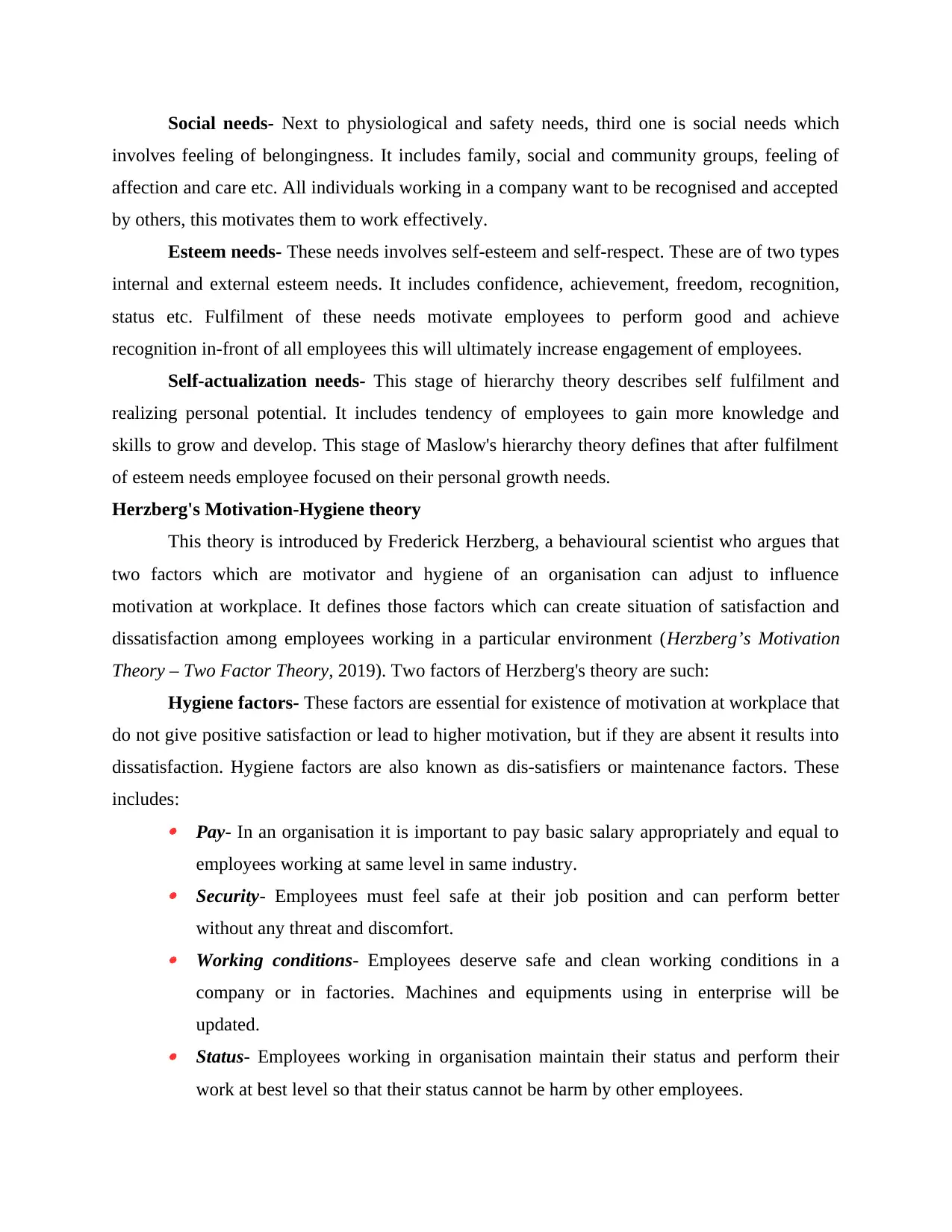
Social needs- Next to physiological and safety needs, third one is social needs which
involves feeling of belongingness. It includes family, social and community groups, feeling of
affection and care etc. All individuals working in a company want to be recognised and accepted
by others, this motivates them to work effectively.
Esteem needs- These needs involves self-esteem and self-respect. These are of two types
internal and external esteem needs. It includes confidence, achievement, freedom, recognition,
status etc. Fulfilment of these needs motivate employees to perform good and achieve
recognition in-front of all employees this will ultimately increase engagement of employees.
Self-actualization needs- This stage of hierarchy theory describes self fulfilment and
realizing personal potential. It includes tendency of employees to gain more knowledge and
skills to grow and develop. This stage of Maslow's hierarchy theory defines that after fulfilment
of esteem needs employee focused on their personal growth needs.
Herzberg's Motivation-Hygiene theory
This theory is introduced by Frederick Herzberg, a behavioural scientist who argues that
two factors which are motivator and hygiene of an organisation can adjust to influence
motivation at workplace. It defines those factors which can create situation of satisfaction and
dissatisfaction among employees working in a particular environment (Herzberg’s Motivation
Theory – Two Factor Theory, 2019). Two factors of Herzberg's theory are such:
Hygiene factors- These factors are essential for existence of motivation at workplace that
do not give positive satisfaction or lead to higher motivation, but if they are absent it results into
dissatisfaction. Hygiene factors are also known as dis-satisfiers or maintenance factors. These
includes:
Pay- In an organisation it is important to pay basic salary appropriately and equal to
employees working at same level in same industry.
Security- Employees must feel safe at their job position and can perform better
without any threat and discomfort.
Working conditions- Employees deserve safe and clean working conditions in a
company or in factories. Machines and equipments using in enterprise will be
updated.
Status- Employees working in organisation maintain their status and perform their
work at best level so that their status cannot be harm by other employees.
involves feeling of belongingness. It includes family, social and community groups, feeling of
affection and care etc. All individuals working in a company want to be recognised and accepted
by others, this motivates them to work effectively.
Esteem needs- These needs involves self-esteem and self-respect. These are of two types
internal and external esteem needs. It includes confidence, achievement, freedom, recognition,
status etc. Fulfilment of these needs motivate employees to perform good and achieve
recognition in-front of all employees this will ultimately increase engagement of employees.
Self-actualization needs- This stage of hierarchy theory describes self fulfilment and
realizing personal potential. It includes tendency of employees to gain more knowledge and
skills to grow and develop. This stage of Maslow's hierarchy theory defines that after fulfilment
of esteem needs employee focused on their personal growth needs.
Herzberg's Motivation-Hygiene theory
This theory is introduced by Frederick Herzberg, a behavioural scientist who argues that
two factors which are motivator and hygiene of an organisation can adjust to influence
motivation at workplace. It defines those factors which can create situation of satisfaction and
dissatisfaction among employees working in a particular environment (Herzberg’s Motivation
Theory – Two Factor Theory, 2019). Two factors of Herzberg's theory are such:
Hygiene factors- These factors are essential for existence of motivation at workplace that
do not give positive satisfaction or lead to higher motivation, but if they are absent it results into
dissatisfaction. Hygiene factors are also known as dis-satisfiers or maintenance factors. These
includes:
Pay- In an organisation it is important to pay basic salary appropriately and equal to
employees working at same level in same industry.
Security- Employees must feel safe at their job position and can perform better
without any threat and discomfort.
Working conditions- Employees deserve safe and clean working conditions in a
company or in factories. Machines and equipments using in enterprise will be
updated.
Status- Employees working in organisation maintain their status and perform their
work at best level so that their status cannot be harm by other employees.
⊘ This is a preview!⊘
Do you want full access?
Subscribe today to unlock all pages.

Trusted by 1+ million students worldwide
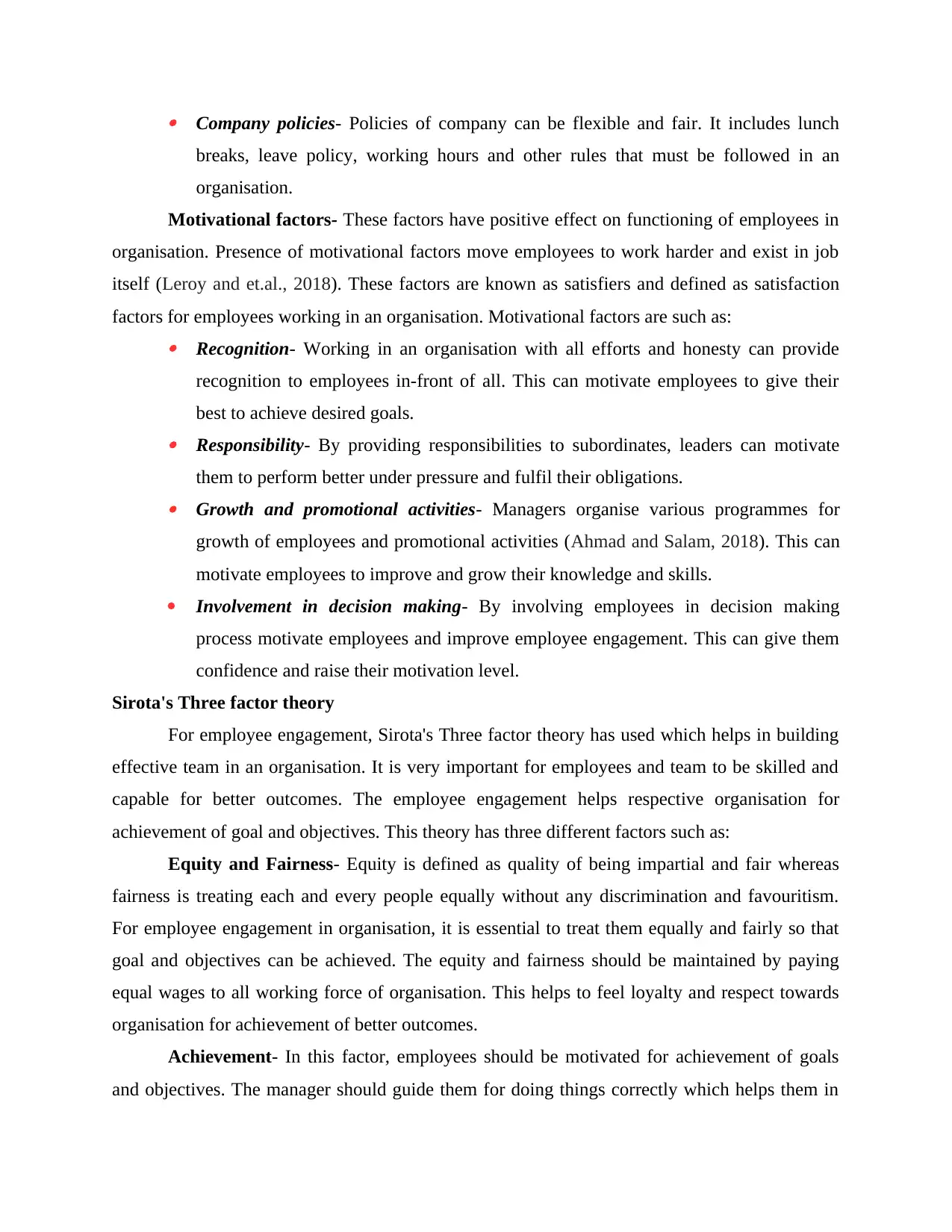
Company policies- Policies of company can be flexible and fair. It includes lunch
breaks, leave policy, working hours and other rules that must be followed in an
organisation.
Motivational factors- These factors have positive effect on functioning of employees in
organisation. Presence of motivational factors move employees to work harder and exist in job
itself (Leroy and et.al., 2018). These factors are known as satisfiers and defined as satisfaction
factors for employees working in an organisation. Motivational factors are such as:
Recognition- Working in an organisation with all efforts and honesty can provide
recognition to employees in-front of all. This can motivate employees to give their
best to achieve desired goals.
Responsibility- By providing responsibilities to subordinates, leaders can motivate
them to perform better under pressure and fulfil their obligations.
Growth and promotional activities- Managers organise various programmes for
growth of employees and promotional activities (Ahmad and Salam, 2018). This can
motivate employees to improve and grow their knowledge and skills.
Involvement in decision making- By involving employees in decision making
process motivate employees and improve employee engagement. This can give them
confidence and raise their motivation level.
Sirota's Three factor theory
For employee engagement, Sirota's Three factor theory has used which helps in building
effective team in an organisation. It is very important for employees and team to be skilled and
capable for better outcomes. The employee engagement helps respective organisation for
achievement of goal and objectives. This theory has three different factors such as:
Equity and Fairness- Equity is defined as quality of being impartial and fair whereas
fairness is treating each and every people equally without any discrimination and favouritism.
For employee engagement in organisation, it is essential to treat them equally and fairly so that
goal and objectives can be achieved. The equity and fairness should be maintained by paying
equal wages to all working force of organisation. This helps to feel loyalty and respect towards
organisation for achievement of better outcomes.
Achievement- In this factor, employees should be motivated for achievement of goals
and objectives. The manager should guide them for doing things correctly which helps them in
breaks, leave policy, working hours and other rules that must be followed in an
organisation.
Motivational factors- These factors have positive effect on functioning of employees in
organisation. Presence of motivational factors move employees to work harder and exist in job
itself (Leroy and et.al., 2018). These factors are known as satisfiers and defined as satisfaction
factors for employees working in an organisation. Motivational factors are such as:
Recognition- Working in an organisation with all efforts and honesty can provide
recognition to employees in-front of all. This can motivate employees to give their
best to achieve desired goals.
Responsibility- By providing responsibilities to subordinates, leaders can motivate
them to perform better under pressure and fulfil their obligations.
Growth and promotional activities- Managers organise various programmes for
growth of employees and promotional activities (Ahmad and Salam, 2018). This can
motivate employees to improve and grow their knowledge and skills.
Involvement in decision making- By involving employees in decision making
process motivate employees and improve employee engagement. This can give them
confidence and raise their motivation level.
Sirota's Three factor theory
For employee engagement, Sirota's Three factor theory has used which helps in building
effective team in an organisation. It is very important for employees and team to be skilled and
capable for better outcomes. The employee engagement helps respective organisation for
achievement of goal and objectives. This theory has three different factors such as:
Equity and Fairness- Equity is defined as quality of being impartial and fair whereas
fairness is treating each and every people equally without any discrimination and favouritism.
For employee engagement in organisation, it is essential to treat them equally and fairly so that
goal and objectives can be achieved. The equity and fairness should be maintained by paying
equal wages to all working force of organisation. This helps to feel loyalty and respect towards
organisation for achievement of better outcomes.
Achievement- In this factor, employees should be motivated for achievement of goals
and objectives. The manager should guide them for doing things correctly which helps them in
Paraphrase This Document
Need a fresh take? Get an instant paraphrase of this document with our AI Paraphraser
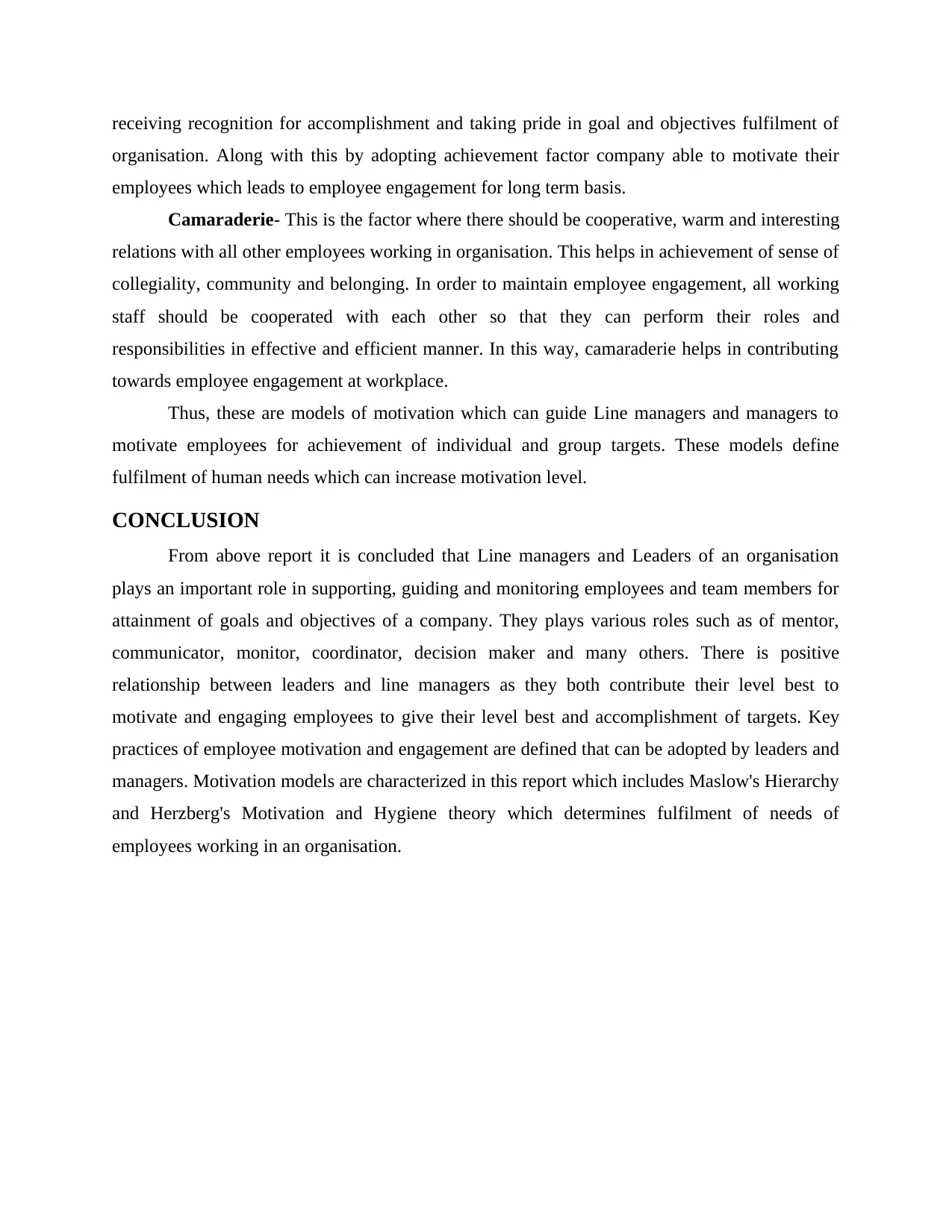
receiving recognition for accomplishment and taking pride in goal and objectives fulfilment of
organisation. Along with this by adopting achievement factor company able to motivate their
employees which leads to employee engagement for long term basis.
Camaraderie- This is the factor where there should be cooperative, warm and interesting
relations with all other employees working in organisation. This helps in achievement of sense of
collegiality, community and belonging. In order to maintain employee engagement, all working
staff should be cooperated with each other so that they can perform their roles and
responsibilities in effective and efficient manner. In this way, camaraderie helps in contributing
towards employee engagement at workplace.
Thus, these are models of motivation which can guide Line managers and managers to
motivate employees for achievement of individual and group targets. These models define
fulfilment of human needs which can increase motivation level.
CONCLUSION
From above report it is concluded that Line managers and Leaders of an organisation
plays an important role in supporting, guiding and monitoring employees and team members for
attainment of goals and objectives of a company. They plays various roles such as of mentor,
communicator, monitor, coordinator, decision maker and many others. There is positive
relationship between leaders and line managers as they both contribute their level best to
motivate and engaging employees to give their level best and accomplishment of targets. Key
practices of employee motivation and engagement are defined that can be adopted by leaders and
managers. Motivation models are characterized in this report which includes Maslow's Hierarchy
and Herzberg's Motivation and Hygiene theory which determines fulfilment of needs of
employees working in an organisation.
organisation. Along with this by adopting achievement factor company able to motivate their
employees which leads to employee engagement for long term basis.
Camaraderie- This is the factor where there should be cooperative, warm and interesting
relations with all other employees working in organisation. This helps in achievement of sense of
collegiality, community and belonging. In order to maintain employee engagement, all working
staff should be cooperated with each other so that they can perform their roles and
responsibilities in effective and efficient manner. In this way, camaraderie helps in contributing
towards employee engagement at workplace.
Thus, these are models of motivation which can guide Line managers and managers to
motivate employees for achievement of individual and group targets. These models define
fulfilment of human needs which can increase motivation level.
CONCLUSION
From above report it is concluded that Line managers and Leaders of an organisation
plays an important role in supporting, guiding and monitoring employees and team members for
attainment of goals and objectives of a company. They plays various roles such as of mentor,
communicator, monitor, coordinator, decision maker and many others. There is positive
relationship between leaders and line managers as they both contribute their level best to
motivate and engaging employees to give their level best and accomplishment of targets. Key
practices of employee motivation and engagement are defined that can be adopted by leaders and
managers. Motivation models are characterized in this report which includes Maslow's Hierarchy
and Herzberg's Motivation and Hygiene theory which determines fulfilment of needs of
employees working in an organisation.
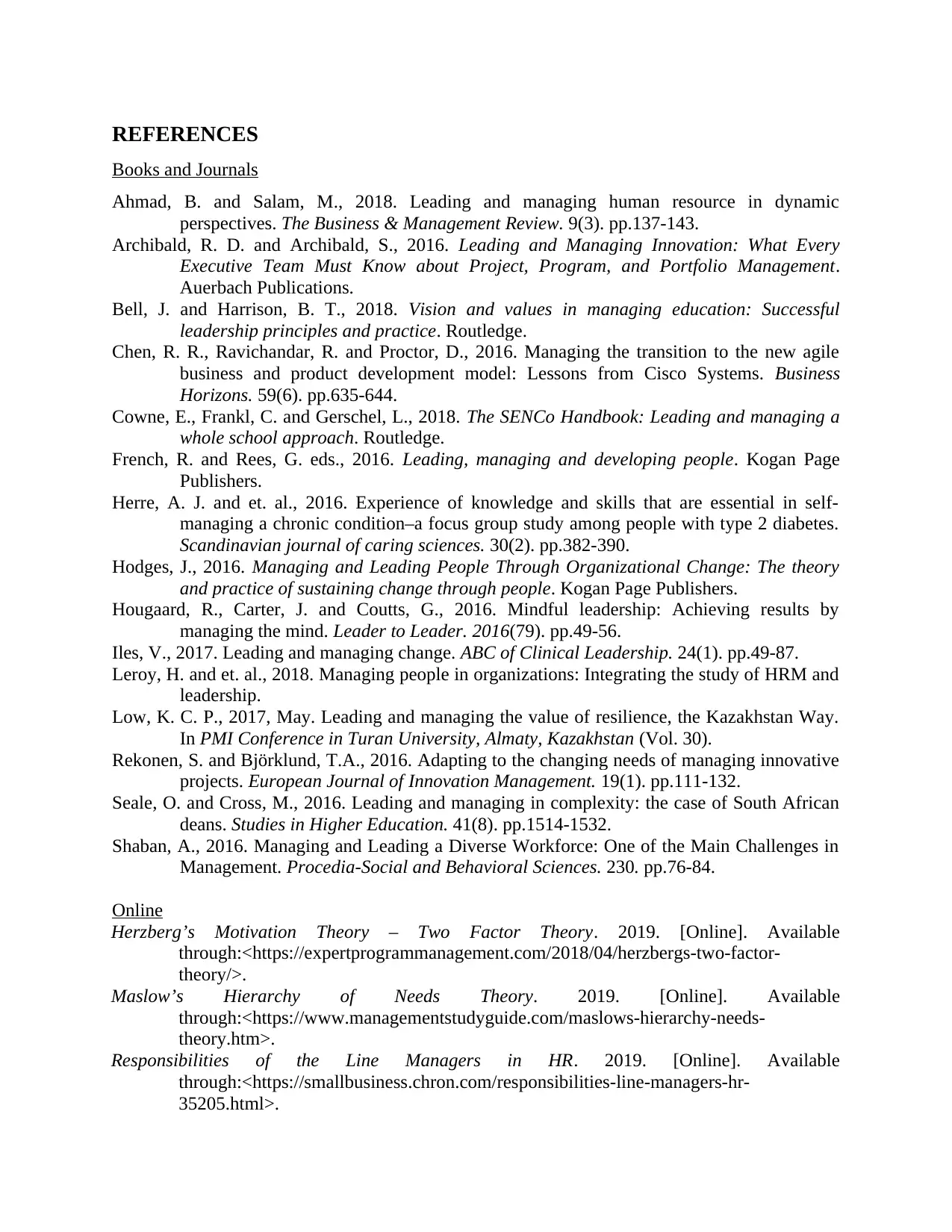
REFERENCES
Books and Journals
Ahmad, B. and Salam, M., 2018. Leading and managing human resource in dynamic
perspectives. The Business & Management Review. 9(3). pp.137-143.
Archibald, R. D. and Archibald, S., 2016. Leading and Managing Innovation: What Every
Executive Team Must Know about Project, Program, and Portfolio Management.
Auerbach Publications.
Bell, J. and Harrison, B. T., 2018. Vision and values in managing education: Successful
leadership principles and practice. Routledge.
Chen, R. R., Ravichandar, R. and Proctor, D., 2016. Managing the transition to the new agile
business and product development model: Lessons from Cisco Systems. Business
Horizons. 59(6). pp.635-644.
Cowne, E., Frankl, C. and Gerschel, L., 2018. The SENCo Handbook: Leading and managing a
whole school approach. Routledge.
French, R. and Rees, G. eds., 2016. Leading, managing and developing people. Kogan Page
Publishers.
Herre, A. J. and et. al., 2016. Experience of knowledge and skills that are essential in self‐
managing a chronic condition–a focus group study among people with type 2 diabetes.
Scandinavian journal of caring sciences. 30(2). pp.382-390.
Hodges, J., 2016. Managing and Leading People Through Organizational Change: The theory
and practice of sustaining change through people. Kogan Page Publishers.
Hougaard, R., Carter, J. and Coutts, G., 2016. Mindful leadership: Achieving results by
managing the mind. Leader to Leader. 2016(79). pp.49-56.
Iles, V., 2017. Leading and managing change. ABC of Clinical Leadership. 24(1). pp.49-87.
Leroy, H. and et. al., 2018. Managing people in organizations: Integrating the study of HRM and
leadership.
Low, K. C. P., 2017, May. Leading and managing the value of resilience, the Kazakhstan Way.
In PMI Conference in Turan University, Almaty, Kazakhstan (Vol. 30).
Rekonen, S. and Björklund, T.A., 2016. Adapting to the changing needs of managing innovative
projects. European Journal of Innovation Management. 19(1). pp.111-132.
Seale, O. and Cross, M., 2016. Leading and managing in complexity: the case of South African
deans. Studies in Higher Education. 41(8). pp.1514-1532.
Shaban, A., 2016. Managing and Leading a Diverse Workforce: One of the Main Challenges in
Management. Procedia-Social and Behavioral Sciences. 230. pp.76-84.
Online
Herzberg’s Motivation Theory – Two Factor Theory. 2019. [Online]. Available
through:<https://expertprogrammanagement.com/2018/04/herzbergs-two-factor-
theory/>.
Maslow’s Hierarchy of Needs Theory. 2019. [Online]. Available
through:<https://www.managementstudyguide.com/maslows-hierarchy-needs-
theory.htm>.
Responsibilities of the Line Managers in HR. 2019. [Online]. Available
through:<https://smallbusiness.chron.com/responsibilities-line-managers-hr-
35205.html>.
Books and Journals
Ahmad, B. and Salam, M., 2018. Leading and managing human resource in dynamic
perspectives. The Business & Management Review. 9(3). pp.137-143.
Archibald, R. D. and Archibald, S., 2016. Leading and Managing Innovation: What Every
Executive Team Must Know about Project, Program, and Portfolio Management.
Auerbach Publications.
Bell, J. and Harrison, B. T., 2018. Vision and values in managing education: Successful
leadership principles and practice. Routledge.
Chen, R. R., Ravichandar, R. and Proctor, D., 2016. Managing the transition to the new agile
business and product development model: Lessons from Cisco Systems. Business
Horizons. 59(6). pp.635-644.
Cowne, E., Frankl, C. and Gerschel, L., 2018. The SENCo Handbook: Leading and managing a
whole school approach. Routledge.
French, R. and Rees, G. eds., 2016. Leading, managing and developing people. Kogan Page
Publishers.
Herre, A. J. and et. al., 2016. Experience of knowledge and skills that are essential in self‐
managing a chronic condition–a focus group study among people with type 2 diabetes.
Scandinavian journal of caring sciences. 30(2). pp.382-390.
Hodges, J., 2016. Managing and Leading People Through Organizational Change: The theory
and practice of sustaining change through people. Kogan Page Publishers.
Hougaard, R., Carter, J. and Coutts, G., 2016. Mindful leadership: Achieving results by
managing the mind. Leader to Leader. 2016(79). pp.49-56.
Iles, V., 2017. Leading and managing change. ABC of Clinical Leadership. 24(1). pp.49-87.
Leroy, H. and et. al., 2018. Managing people in organizations: Integrating the study of HRM and
leadership.
Low, K. C. P., 2017, May. Leading and managing the value of resilience, the Kazakhstan Way.
In PMI Conference in Turan University, Almaty, Kazakhstan (Vol. 30).
Rekonen, S. and Björklund, T.A., 2016. Adapting to the changing needs of managing innovative
projects. European Journal of Innovation Management. 19(1). pp.111-132.
Seale, O. and Cross, M., 2016. Leading and managing in complexity: the case of South African
deans. Studies in Higher Education. 41(8). pp.1514-1532.
Shaban, A., 2016. Managing and Leading a Diverse Workforce: One of the Main Challenges in
Management. Procedia-Social and Behavioral Sciences. 230. pp.76-84.
Online
Herzberg’s Motivation Theory – Two Factor Theory. 2019. [Online]. Available
through:<https://expertprogrammanagement.com/2018/04/herzbergs-two-factor-
theory/>.
Maslow’s Hierarchy of Needs Theory. 2019. [Online]. Available
through:<https://www.managementstudyguide.com/maslows-hierarchy-needs-
theory.htm>.
Responsibilities of the Line Managers in HR. 2019. [Online]. Available
through:<https://smallbusiness.chron.com/responsibilities-line-managers-hr-
35205.html>.
⊘ This is a preview!⊘
Do you want full access?
Subscribe today to unlock all pages.

Trusted by 1+ million students worldwide
1 out of 13
Related Documents
Your All-in-One AI-Powered Toolkit for Academic Success.
+13062052269
info@desklib.com
Available 24*7 on WhatsApp / Email
![[object Object]](/_next/static/media/star-bottom.7253800d.svg)
Unlock your academic potential
Copyright © 2020–2025 A2Z Services. All Rights Reserved. Developed and managed by ZUCOL.





